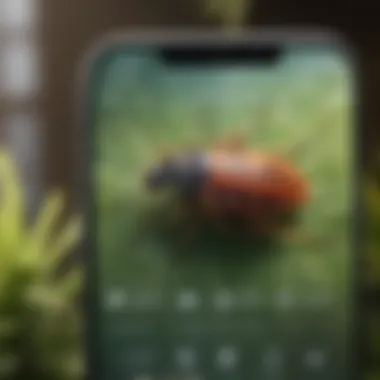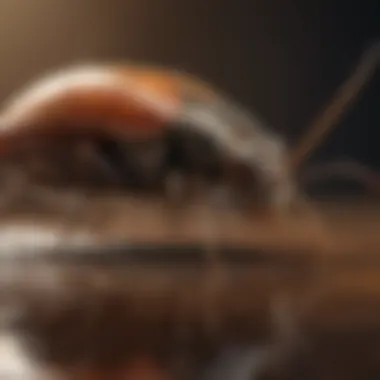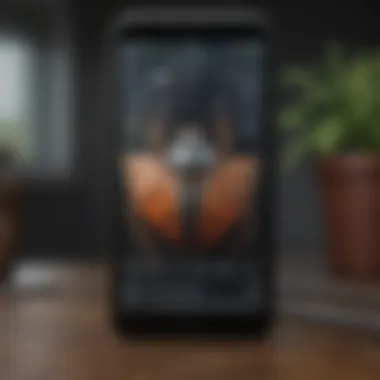Best Bug Identifier App: A Comprehensive Guide


Intro
Understanding pests is essential for effective management and control. Many households face challenges with various insects and pests that can damage property or harm health. With the advancement of technology, bug identifier apps have emerged as a practical solution for homeowners. These tools offer the ability to identify pests quickly and efficiently, which is an important step in pest management. The information provided in this article will offer insights into these apps and how they play a pivotal role in pest identification and management.
Understanding Pests
Definition of Pests
Pests are organisms that are unwanted and pose a threat to human health, plants, or property. They include insects such as ants, termites, and cockroaches, among others. Additionally, some might consider weeds and rodents as pests. The key characteristic of pests is their potential to cause damage or spread diseases. By defining pests clearly, we can work towards more effective identification and management strategies.
Importance of Pest Identification
Recognizing the specific type of pest is crucial for several reasons. First, it allows for targeted treatment, which can be more effective and environmentally friendly. Understanding the habits and life cycles of pests helps homeowners know when and how to act. Additionally, accurate identification can prevent unnecessary use of chemicals, thus reducing environmental impact. Successful pest management relies heavily on proper identification, making it an indispensable skill for any homeowner.
Prevention Techniques
Home and Garden Preventative Measures
Preventative measures are essential in reducing the likelihood of pest infestations. Simple actions can make a significant difference:
- Seal Entry Points: Make sure windows, doors, and any cracks are sealed to prevent pests from entering.
- Regular Cleaning: Keep areas clean and free of food debris. This is particularly important in kitchens.
- Proper Waste Management: Ensure garbage cans are tightly closed and regularly emptied.
- Maintain Gardens: Trim shrubs and trees to avoid creating hiding spots for pests.
These strategies help maintain a pest-free environment and reduce the risk of infestations.
Seasonal Prevention Tips
The changing seasons often bring different pests into the home. Adapting your prevention strategies seasonally can be more effective:
- Spring: Inspect for early signs of infestations and apply barriers to entry points.
- Summer: Maintain gardens and edges to disrupt pest habitats.
- Fall: Remove any food sources that attract pests as they prepare for winter.
- Winter: Check for any cracks in insulation and cover them before the cold fully sets in.
By adjusting approaches to pests based on the season, homeowners can stay one step ahead of potential infestations.
Eco-Friendly Pest Control Solutions
Overview of Sustainable Practices
As awareness of environmental issues grows, many are seeking eco-friendly pest control options. Sustainable practices focus on managing ecosystems rather than merely exterminating pests. Techniques include:
- Biodiversity: Encouraging a variety of plants can attract natural predators of pests.
- Biological Control: Using beneficial insects to manage harmful pest populations.
- Chemical Alternatives: Relying on non-toxic solutions for pest management.
These strategies not only safeguard the environment but also maintain the health of the living space.
Natural Remedies and Their Effectiveness
Natural remedies work well for many common pests and can often be just as effective as chemical treatments:
- Diatomaceous Earth: This powder can eliminate many crawling insects by dehydrating them.
- Soap and Water: A simple solution can address soft-bodied insects like aphids.
- Essential Oils: Certain oils, like peppermint and lavender, are known to deter pests.


Such remedies offer safer alternatives for pest control, especially for households with children or pets.
"Identifying the pest correctly is the first step toward effective management and eradication."
Prelude to Bug Identification Apps
The world around us is filled with various bugs and pests, some beneficial and others potentially harmful. Understanding the distinctions is crucial for effective pest control and management. The emergence of bug identifier apps represents a breakthrough in this field, offering users the ability to identify insects quickly and accurately. This technology serves multiple functions, ranging from herbal gardening to urban pest management.
Importance of Identifying Bugs
Identifying bugs is essential for several reasons. First, it allows homeowners and gardeners to manage pests effectively. Knowing which insects are present can inform decisions about control methods. Some bugs may be harmless or even beneficial, such as pollinators, while others may threaten plants, pets, or human health.
Moreover, timely identification can prevent extensive damage. Homeowners who recognize a pest issue early can often deal with it before it becomes a more significant problem. This proactive approach helps save time, effort, and resources, ensuring that pest-related issues do not escalate.
The Role of Technology in Pest Management
Technology plays a pivotal role in modern pest management. Bug identifier apps harness the power of mobile technology and vast databases to provide users with immediate access to critical information. These applications allow users to take a picture of an insect, and within moments, receive feedback on its identity.
The accuracy of these apps has improved due to advancements in machine learning and artificial intelligence. As more users engage with these platforms, the databases become richer and more refined, allowing for better identification results. This integration of technology not only enhances user experience but also opens new pathways for studying insect behavior and population patterns.
"With the right tools, anyone can effectively manage pest issues, fostering a healthier environment at home and in the garden."
Criteria for Selecting the Best Bug Identifier Apps
Selecting the right bug identifier app is essential for effective pest management. This section outlines the key criteria that users should consider when evaluating these applications. Each criterion plays a significant role in ensuring that the app serves its purpose effectively. A well-selected app can make the process of pest identification more accurate and efficient. Below, we explore various aspects that contribute to the success of these applications.
Database Size and Comprehensive Coverage
One of the primary factors to consider is the database size of the bug identifier app. A larger database typically indicates a broader range of species being covered. This is crucial for both novice users and seasoned pest controllers. The app's ability to provide comprehensive coverage means that users can identify a variety of bugs accurately, minimizing the risk of misidentification. An app with a good database should also include information on local species, which can vary significantly from one region to another.
A comprehensive database ensures users have relevant examples, which enhances learning and results in more informed pest management decisions.
Moreover, the app should regularly update its database to include new findings in entomology, making it more reliable over time. This attempt is important, as pest species can evolve, and new bugs may emerge. Users should opt for apps that demonstrate a commitment to maintaining and enhancing their database.
User-Friendliness and Accessibility
Another critical aspect of bug identifier apps is their user-friendliness and accessibility. An intuitive interface makes a significant difference, especially for users who may not be technologically savvy. The layout should make navigation easily understandable. Key features should also be straightforward to access without overwhelming users with unnecessary options.
The inclusion of clear instructions or tutorial features can greatly aid new users. Accessibility is also about having the app available on multiple platforms, such as Android and iOS, which ensures a wider audience can benefit from it. Furthermore, language options can enhance accessibility for non-native English speakers, making it usable for a broader range of people.
Features and Functionalities
It is essential to assess the specific features and functionalities of each bug identifier app. Users should look for apps that offer image recognition, as this technology allows users to snap a photo of an insect and receive instant identification. Some apps may also provide options for reporting bugs, assisting in tracking pest populations.
Additional functionalities to consider include:
- A community forum for sharing experiences and advice.
- Educational resources related to pest management.
- Tools for logging pest activity over time, allowing for better pest control strategies.


These features not only add value but also engage users more effectively, turning the app into a comprehensive pest management tool rather than just an identification platform.
User Reviews and Feedback
Finally, one cannot overlook the importance of user reviews and feedback. Reviews from actual users provide insights into the app’s performance and reliability. They can often highlight strengths and weaknesses that may not be apparent from the app’s promotional materials. When checking feedback, potential users should look for patterns in the reviews rather than single comments. This helps to generate a more accurate assessment of the app's value.
Additionally, checking how quickly developers respond to feedback and update the app can signal the level of support and commitment towards improving the user experience. A responsive developer can dramatically enhance user satisfaction and trust in the application's effectiveness.
Overview of Leading Bug Identifier Apps
Understanding the landscape of bug identifier apps is crucial for anyone looking to manage pests effectively. These applications are not merely tools; they serve as essential resources that tap into technology to support home and garden care. With a variety of options available, users need to assess the features and capabilities of each app to find the most suitable match for their specific needs. This section will explore three leading bug identifier apps, elaborating on their unique attributes, user experiences, and overall effectiveness in pest identification.
App One: Features and Capabilities
This app stands out primarily due to its extensive database. Users can explore thousands of species, making identification more reliable. The process is straightforward: you upload a photo, and the app analyzes it, presenting possible matches. Advanced features include expert advice and community contributions, which enhance the overall user experience. Its offline mode is also a valuable asset, allowing users to access data without requiring a constant internet connection.
App Two: User Experience and Reviews
User feedback is critical in evaluating an app's practicality. This particular app is praised for its intuitive interface. Reviews highlight how even novice users find it simple to navigate. Community forums integrated into the app foster交流 and provide real-time advice, which improves user confidence when handling pest control practices. Many users mention that the app’s ability to provide localized information is a significant advantage, especially for those in varying climates.
App Three: Comparison of Effectiveness
In comparing the three highlighted apps, effectiveness in identifying pests becomes the focal point. This app often shows higher accuracy rates based on extensive testing with real-life situations. Its unique algorithm considers several factors, from image quality to context, enabling it to deliver robust identifications. Additionally, user testimonials frequently emphasize the app�’s usefulness in not only identifying bugs but also suggesting preventative measures, adding tremendous value to homeowners.
"The ability to accurately identify a pest was the turning point in saving my garden from destruction. This app did not just help identify; it empowered me to act."
By reviewing the functionalities and user experiences of these leading bug identifier apps, homeowners and housewives can make informed decisions on which tools may best suit their pest management strategies.
How to Utilize Bug Identifier Apps Effectively
Utilizing bug identifier apps is essential for homeowners and garden enthusiasts who face pest issues. These tools not only simplify the identification of potential threats but also provide insights into effective management strategies. Understanding how to use these apps efficiently can greatly enhance your pest management practices. This section covers considerations, benefits, and practical steps to maximize the effectiveness of bug identifier apps in your pest control efforts.
Step-by-Step Guide to Using the Apps
Using bug identifier apps can be straightforward if you follow a step-by-step approach. Here are the typical steps for utilizing these applications:
- Download and Install the App: Begin by selecting a suitable app from your device's app store. Popular choices include iNaturalist and PlantSnap. After downloading, install the app and create an account if needed.
- Familiarize Yourself with the Interface: Spend a few minutes navigating through the app interface. Look for sections that allow you to capture images, access databases, or explore identification features.
- Capture an Image of the Bug: When facing a bug, take clear photos from different angles. Good lighting will help you capture distinct features of the pest. Many apps allow you to use the camera directly within the app.
- Submit the Image for Identification: Upload your image according to the app's instructions. Some apps may provide immediate results, while others may require you to wait for community feedback.
- Review Identification Results: Examine the suggested identifications carefully. Review the provided details, such as common names, pest behavior, and possible management strategies.
- Take Action Based on Findings: Once you identify the bug, consider the recommended control methods. The app may guide you on whether to remove the pest, apply insecticides, or accept it as harmless.
"Utilizing bug identifier apps allows for prompt and informed decision-making in pest management, benefiting both gardens and homes."
By following these steps, users can effectively navigate different bug identifier apps, making pest identification more accessible and efficient.
Integrating with Other Pest Management Tools
While bug identifier apps are valuable on their own, integrating them with other pest management tools can further enhance your pest control strategies. Here’s how you can effectively combine these technologies:
- Combine with Traps: Use physical traps for monitoring pest populations and then cross-reference trapped bugs with your app's identification capabilities. This synergy helps in tracking pest behavior over time.
- Link with Treatment Solutions: Some apps suggest specific treatments based on bug identification. Pair these recommendations with commercial solutions, like Bayer Advanced or Ortho Bug B-Gone, for comprehensive pest control.
- Incorporate Data Logging: Keep a log of pest sightings and app identifications. This data can help in recognizing patterns or seasonal infestations, which can be crucial when managing long-term pest issues.
- Community Forums: Use community features of apps like iNaturalist to share findings. Engaging with others can lead to practical tips and advice that complement your app experience.


By integrating bug identifier apps with other tools and resources, homeowners and gardeners can create a more robust pest management strategy, leading to better results and a healthier environment.
Real-Life Applications of Bug Identifier Apps
The practical use of bug identifier apps offers significant advantages for various user groups. The transition from traditional methods of pest identification to mobile technology has changed how homeowners and gardeners approach pest management. With a few taps on a screen, users can access a wealth of information that aids in identifying pests and also provides guidance on how to manage them effectively.
Case Studies: Homeowners and Gardeners
Homeowners often face pests that can impact their living spaces, gardens, and overall health. For instance, a homeowner in suburban Chicago discovered an infestation of aphids using a bug identifier app. By uploading a clear photo, the app’s database quickly identified the pest and provided recommendations.
Moreover, a gardener from California utilized the same app to identify beneficial insects against the backdrop of confusing bug varieties. With this tool, she could differentiate between the pests that harm her plants and those that help in pollination. These apps educate users about ecological balance, which is vital for sustainable practices.
Behavioral Patterns in Pest Management
As users interact with bug identifier apps, patterns in pest management emerge. Many individuals tend to check for pests proactively during specific seasons, such as spring and summer. The data gathered offers insights into when certain pests are most active. Additionally, a growing number of users share their observations on platforms like Reddit, helping to create a community of informed individuals who rely on shared experiences and insights. Their findings can further enhance how these apps evolve.
Overall, these real-life applications show that bug identifier apps can transform pest management from a reactive to a proactive practice. By utilizing technology, homeowners and gardeners not only identify pests but also foster relationships with their environments.
Future Trends in Bug Identification Technology
As technology continues to evolve, the future of bug identification applications presents a myriad of possibilities that can significantly enhance pest management. The integration of advanced technologies into these apps will not only improve accuracy but also accessibility for users. Understanding future trends is vital for homeowners and gardeners who depend on these tools for effective pest control. By exploring upcoming advancements, individuals can better prepare for the tools that will shape how they interact with nature and manage pests.
Advancements in AI and Machine Learning
Artificial intelligence and machine learning are at the forefront of the future of bug identification. These technologies allow apps to learn from user input and behavioral patterns. For instance, an app like Seek by iNaturalist utilizes machine learning algorithms to analyze pictures of insects and provide accurate identifications quickly.
Benefits of AI integration include:
- Increased Accuracy: The app improves its recognition capabilities over time based on a growing database and user feedback.
- Real-Time Data Analysis: Users receive instant feedback on their finds, enhancing the overall utility of the app.
- Personalized User Experience: AI learns from each user’s preferences and often used features, thus making the tool more caterable.
Future implementations may focus on more intuitive interfaces that provide immediate solutions for pest problems, streamlining the identification process into a more user-friendly experience.
Increased Accessibility and Community Involvement
Another significant trend is the increased accessibility of bug identifier apps. As smartphones become ubiquitous, the availability of these applications for every type of user is crucial. Enhanced accessibility means that even those with minimal technological skills can effectively use these tools.
A central aspect of this trend involves community involvement. Apps that encourage user contributions, such as recordings of pest findings or experiences, foster a more collaborative environment. Benefits include:
- Crowdsourced Data: These contributions lead to the growth of diverse databases, improving the accuracy of pest identification.
- User Education: Involving the community enables users to learn from each other’s experiences, enhancing knowledge and pest management strategies.
- Localized Solutions: Local community data can provide insights specific to regional pest issues, increasing relevance for users.
In summary, the convergence of AI advancements and community involvement will transform bug identification technology into a robust tool for future pest management. By embracing these trends, homeowners and gardeners can lay the groundwork for a more effective approach to dealing with pests.
End
The conclusion is a vital part of this article as it synthesizes the key insights on bug identifier apps. In today's world where pest management is essential for homeowners and gardeners alike, understanding the functionality and the effectiveness of these apps can lead to better-informed decisions. A thorough evaluation of bug identifier apps not only highlights their features but also showcases user experiences, enabling users to leverage technology effectively in their daily lives.
Summary of Findings
In reviewing the best bug identifier apps, several key points emerge. Firstly, comprehensive coverage of pest types is crucial. Apps with extensive databases usually provide more reliable identification and management solutions. Also, user-friendliness was a significant factor. Apps that prioritize ease of access and intuitive navigation tend to receive favorable feedback. Moreover, functionalities such as image recognition and community support enhance the practical utility of these apps for users, making them indispensable tools for effective pest management.
"Using bug identifier apps can transform the approach to pest control by making it more accessible for non-experts."
Final Thoughts on Bug Identifier Apps
In summary, bug identifier apps pave the way for modern pest management. They combine technology with practical needs, offering users detailed insights that promote proactive pest control strategies. Homeowners and gardeners who adopt these applications stand to benefit from improved identification and, consequently, better management practices. However, as technology evolves, users should remain updated on these tools. Continuous learning and adaptation will maximize the effectiveness of pest control efforts and safeguard homes and gardens from unwelcome visitors.



